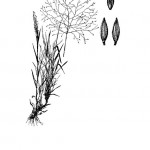Fall Witchgrass
Digitaria cognata
Poaceae
Description
Fall Witchgrass has many branching stems that emerge from a horizontal, usually hairy base. These stems are slender, wiry, knotty, and pubescent. Stems generally measure 12 to 24 inches or 30 to 60 cm long. The plant, as a whole, presents as a pale green, maturing to a golden hue. The short, rigid, flat blades have white edges. One edge is often crinkled resembling a hacksaw blade or bacon cooking in a frying pan. Their upper surface is rough. The blades can be up to 0.5 cm (about 0.2 in) wide by 10 cm (about 3.94 in) long. The inflorescence resembles a small broom (spreading out at maturity) with single, fuzzy, oval, spikelets which produce small, awn-less seeds. The panicles break off at maturity, forming tumbleweeds. These panicles can be around 12 inches or 30 cm long, up to half the stem height. The strongly pubescent spikelets are less than 0.13 inches or 3.3 mm long, pedicelled, and comprised of two florets. Flowering occurs from May to November. Fall Witchgrass is a perennial, warm-season, native grass that provides fair grazing for both livestock and wildlife, but poor forage for deer.Habitat
Grows on dry, rocky, or sandy soil usually in moderately disturbed open prairies. Robert Shaw in Guide to Texas Grasses states that Fall Witchgrass is “found throughout most of the state east of the 100th meridian, rarer to the west.”Images
Plant Characteristics
Seed Type: Non-Encapsulated
Duration: Perennial
Stem Texture: Hairy
Growth Habit: Bunch grass, Grasses
Leaf Shape
 : Simple with Pinnate or Parallel Venation
: Simple with Pinnate or Parallel Venation
Season: Warm
Distribution
 : 01 - Pineywoods, 02 - Gulf Prairies and Marshes, 03 - Post Oak Savannah, 04 - Blackland Prairies, 05 - Cross Timbers and Prairies, 06 - South Texas Plains, 07 - Edwards Plateau, 08 - Rolling Plains, 09 - High Plains, 10 - Trans-Pecos
: 01 - Pineywoods, 02 - Gulf Prairies and Marshes, 03 - Post Oak Savannah, 04 - Blackland Prairies, 05 - Cross Timbers and Prairies, 06 - South Texas Plains, 07 - Edwards Plateau, 08 - Rolling Plains, 09 - High Plains, 10 - Trans-Pecos
Distributions
Distribution refers to the ecological region in Texas that a plant has been found. You can also view a clickable map.
Book: Know Your Grasses (B-182)
Collection: Grasses


